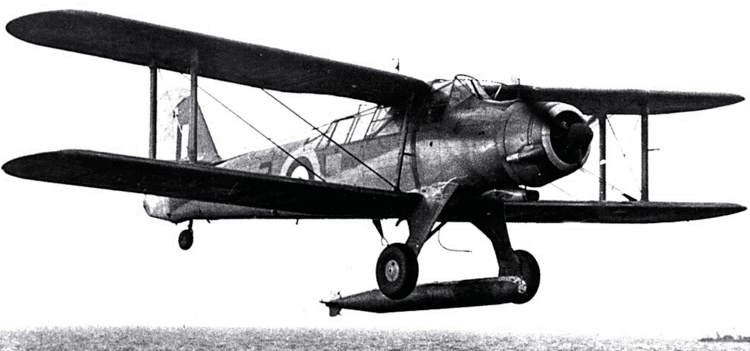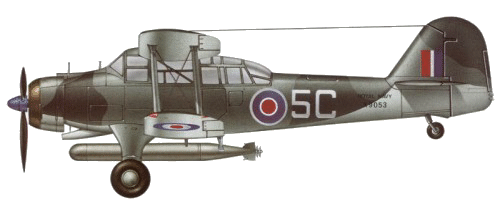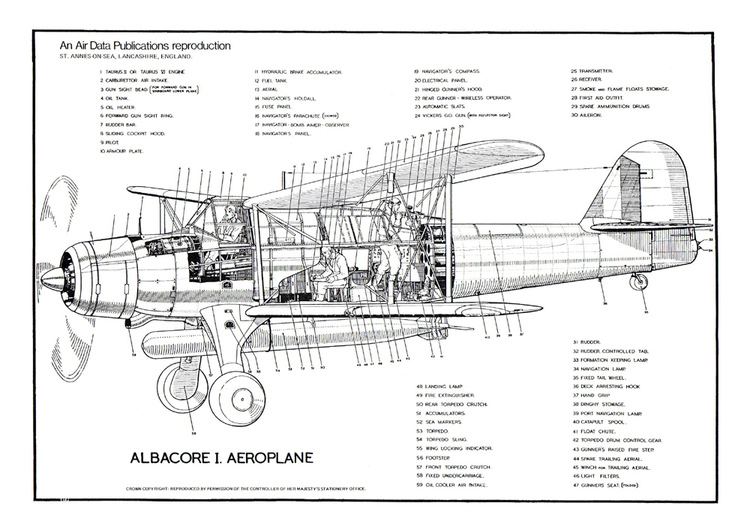Top speed 259 km/h Wingspan 15 m Cruise speed 225 km/h First flight 1938 | Range 1,497 km Length 12 m | |
 | ||
The Fairey Albacore was a British single-engine carrier-borne biplane torpedo bomber built by Fairey Aviation between 1939 and 1943 for the Royal Navy Fleet Air Arm and used during the Second World War. It had a three-man crew and was designed for spotting and reconnaissance as well as level bombing, dive bombing and as a torpedo bomber. The Albacore, popularly known as the "Applecore", was conceived as a replacement for the ageing Fairey Swordfish, which had entered service in 1936. The Albacore served with the Swordfish and was retired before it, being replaced by the Fairey Barracuda and Grumman Avenger monoplane torpedo bombers.
Contents
- Ww2 raf fairey albacore image hd ww2 raf fairey albacore imagen hd
- Design and development
- Operational history
- Operators
- Surviving aircraft
- Specifications Albacore
- References

Ww2 raf fairey albacore image hd ww2 raf fairey albacore imagen hd
Design and development

The Albacore prototypes were built to meet Specification S.41/36 for a three-seat TSR (torpedo/spotter/reconnaissance) for the FAA to replace the Swordfish. The Albacore was designated TBR (torpedo/bomber/reconnaissance) and like the Swordfish, was fully capable of dive bombing:

The Albacore was designed for diving at speeds up to 215 knots (400 km/h) IAS with flaps either up or down, and it was certainly steady in a dive, recovery being easy and smooth...

and the maximum under wing bomb load was 4 x 500 lb bombs. The Albacore had a more powerful engine than the Swordfish and was more aerodynamically refined. It offered the crew an enclosed and heated cockpit and the Albacore also had an automatic liferaft ejection system that triggered in the event of the aircraft ditching.

The first of two prototypes flew on 12 December 1938 and production of the first batch of 98 aircraft began in 1939. Early Albacores were fitted with the Bristol Taurus II engine and those built later received the more powerful Taurus XII. Boscombe Down testing of the Albacore and Taurus II engine, in February 1940, showed a maximum speed of 160 mph (258 km/h), at an altitude of 4,800 ft (1,463 m), at 11,570 lb (5,259 kg), which was achieved with four under-wing depth charges, while maximum speed without the depth charges was 172 mph (277 km/h). An Albacore fitted with the Taurus II engine and carrying a torpedo weighed 11,100 lb (5,045 kg).
A total of 800 Albacores were built, including two prototypes which were all built at Fairey's Hayes Factory and test flown at what is now London Heathrow Airport.
Operational history
No. 826 Naval Air Squadron was specially formed to operate the first Albacores in March 1940, being used for attacks against harbours and shipping in the English Channel, operating from shore bases and for convoy escort for the rest of 1940. HMS Formidable's 826 and 829 Squadrons were the first to operate the Albacore from a carrier, with operations starting in November 1940. Initially, the Albacore suffered from reliability problems with the Taurus engine, although these were later solved, so that the failure rate was no worse than the Pegasus equipped Swordfish. The Albacore remained less popular than the Swordfish, as it was less manoeuvrable, with the controls being too heavy for a pilot to take much evasive action after dropping a torpedo.
Eventually, there were 15 first-line FAA squadrons equipped with the Albacore which operated widely in the Mediterranean. Albacores played a prominent role in the ill-fated raid on Kirkenes and Petsamo in July 1941. Albacores participated with more success in the Battle of Cape Matapan and the fighting at El Alamein as well as supporting the landings at Sicily and Salerno. During the period September 1941 to end of June 1943, No. 828 Squadron, based at RAF Hal Far, Malta, operated a squadron of Albacores under severe blitz conditions during the siege of Malta, mainly against Italian shipping and shore targets in Sicily.
On 9 March 1942, 12 Albacores from HMS Victorious were launched to attack the German Bismarck-class battleship Tirpitz at sea near Narvik. Based on information from one of six radar equipped aircraft already airborne, Albacores from 817 and 832 Squadrons launched torpedoes and some also attacked with their machine guns. One attack came within 30 ft of success at the bow but the FAA's only torpedo attack on the Tirpitz at sea failed, with the loss of two aircraft and damage to many others.
In 1943, the Albacore was progressively replaced in Fleet Air Arm service by the Barracuda. The last FAA Albacore squadron, No. 841 Squadron, which had been used for shore based attacks against shipping in the Channel for the whole of its career with the Albacore, disbanded in late 1943.
The Royal Air Force deployed some Albacores; No. 36 Squadron based at Singapore acquired five to supplement its Vickers Vildebeests at RAF Seletar in December 1941. The remnants of the squadron was captured by the Japanese in March 1942. In 1943, No. 415 Squadron RCAF was equipped with Albacores (presumably ex-FAA) before the Flight operating them was transferred and reformed as 119 Squadron at RAF Manston in July 1944. The squadron deployed later to Belgium. Their Albacores were disposed of in early 1945 in favour of ASV-radar equipped Swordfish Mk.IIIs that the squadron kept until the end of the war in May. The Aden Communication Flight used 17 Albacores between the middle of 1944 and August 1946. Some of these were delivered by sea on the SS Empire Arun in December 1945 (all from Royal Navy stock).
The Royal Canadian Air Force took over the Albacores and used them during the Normandy invasion, for a similar role until July 1944. The Albacore was the last biplane to be used in combat by the RCAF.
Operators
Surviving aircraft
Only one Albacore is known to survive, on display at the Fleet Air Arm Museum, which was built using parts of Albacores N4389 and N4172 recovered from crash sites.
Specifications (Albacore)
Data from The British Bomber since 1914
General characteristics
Performance
Armament
